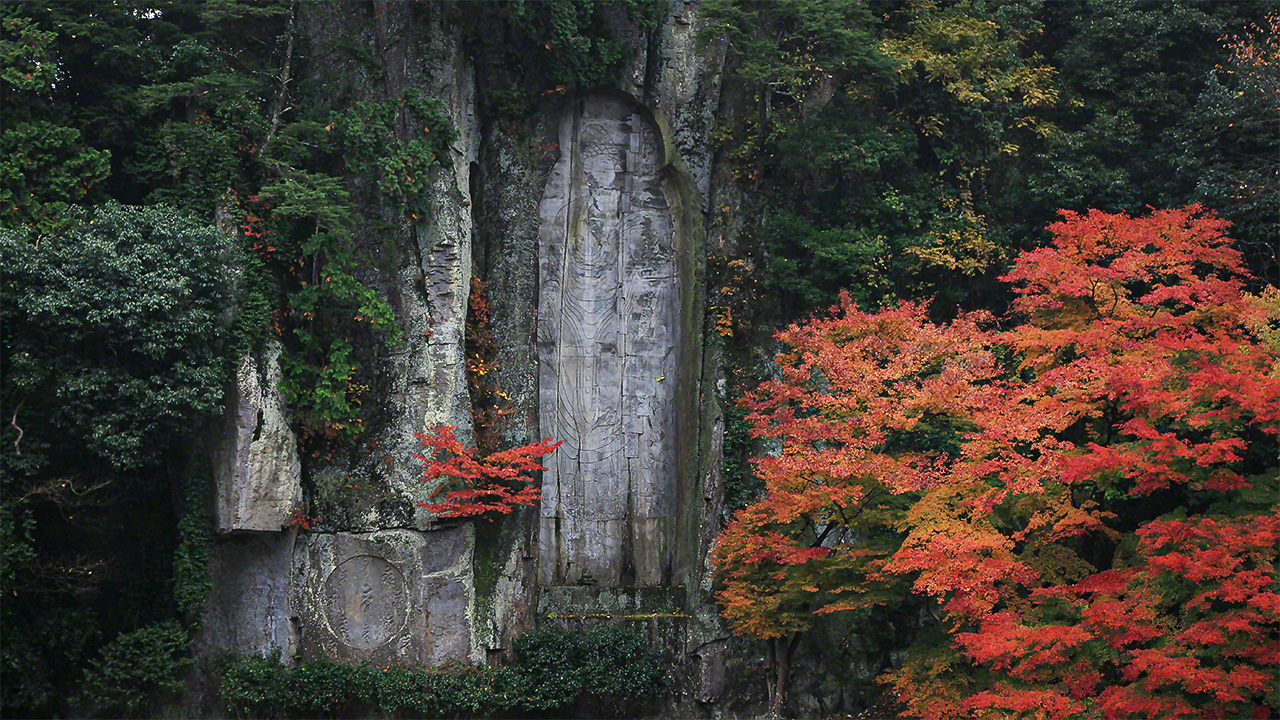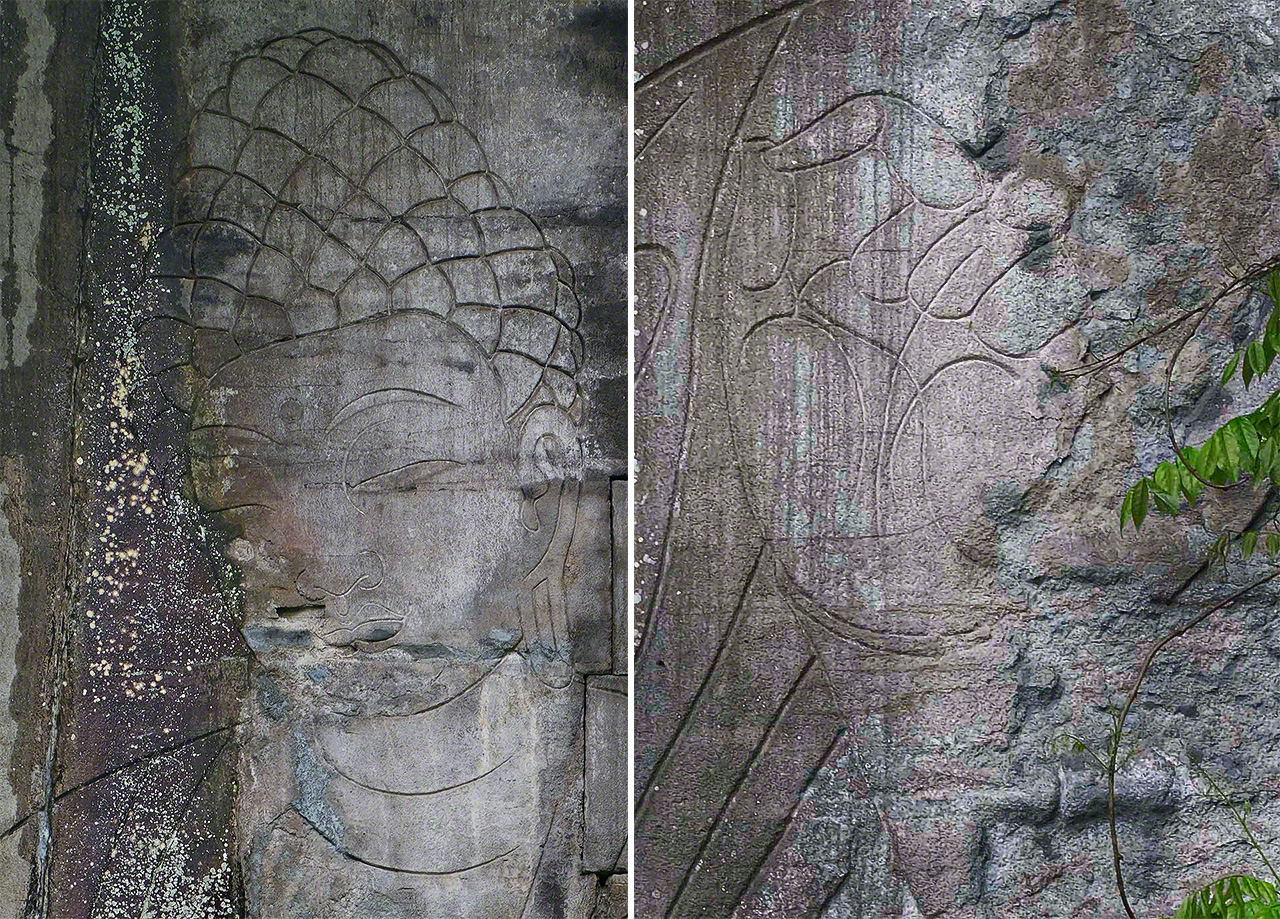
Rock Carving of the Bodhisattva Maitreya at Ōnodera, Nara
Culture Art Images Guide to Japan- English
- 日本語
- 简体字
- 繁體字
- Français
- Español
- العربية
- Русский
Ōnodera is a small temple with an ancient history. Belonging to the Murōji branch of the Shingon school, the temple stands on the banks of the Udagawa River in tranquil Uda in Nara Prefecture, about an hour by train from Nara itself. Ōnodera’s main claim to fame stands just outside the temple grounds: a giant rock carving of the bodhisattva Miroku (Maitreya, the Buddha of the future), hewn into the cliff on the opposite bank of the clear-flowing Udagawa River.
More than 800 years ago, sculptors and stone masons clambered over rudimentary scaffolding made from wood and bamboo, working to hollow a giant halo-shaped cavity more than 13 meters tall out of the cliff-face. They then smoothed and polished the area and engraved intricate lines into the rock to form a vivid image of Maitreya fully 11.5 meters high. Even if it is not quite as large as the famous Great Buddha at Tōdaiji in Nara (15 meters tall), this is nevertheless thought to be the largest magaibutsu (rock Buddha) anywhere in Japan. The image wears monk’s robes across the shoulder, and stands with his head bent at an angle to the right, his long, narrow eyes casting a look of compassion on all living things. His feet stand on two separate lotus pedestals, in a pose known as fumiwari renge-za.

(© Muda Tomohiro)
According to tradition, Ōnodera was established in the Asuka Period (593–710) by En no Ozuno, founder of the Shugendō tradition of syncretic beliefs and esoteric practices. In the Heian Period (794–1185), Kūkai (also known as Kōbō Daishi) is credited with having constructed more permanent temple buildings on the site, which he named Jison’in Mirokuji (Hall of the Compassionate One, Temple of Maitreya). Ōnodera shares with Murōji the same legendary founders and associations with Kūkai, and it is likely that the two temples have been closely connected since ancient times. Ōnodera is often visited by people on their way to or from Murōji, just 3.5 kilometers away, and is known as the “western gate of Murōji.”
The cliff sculpture of Maitreya was carved at the beginning of the Kamakura period (1185–1333), in fulfillment of a vow by Gaen, a senior monk at the Kōfukuji temple in Nara. The carving, completed in 1207, is believed to have been modeled on a statue dating from the Asuka period that was the chief image at the temple Kasagidera in Kyoto. The sculpture was made by Sōkei, one of the famous Kei school of sculptors. Stone masons from Song China, who had come to Japan to help rebuild Tōdaiji (largely destroyed during the Genpei Wars between the Taira and Minamoto warrior clans at the end of the Heian period), also worked on the project. The official “opening of the eyes” ceremony to mark the completion of the image took place on the seventh day of the third month, 1209. Among those in attendance was the cloistered emperor Gotoba.

The image is shown making a mudra, or ritual gesture, in which the thumb and index finger are joined together in a circle. (© Muda Tomohiro)
Until the Heian period, Japanese Buddhist sculptures in stone were often reliefs hewn like this into the face of the rock, but from the Kamakura period on, freestanding sculptures in the round became more common. This excellently preserved carving from the early Kamakura period, with its clear and elegant lines, is therefore an extremely important late example. The flowing lines show the influence of the new style of Buddhist sculpture introduced from Song China, which used innovative techniques to realistically reproduce lithe and natural movements. This masterpiece towers over the river and covers a cliff face in the mountains far from the nearest human settlements. It is an impressive sight even today. One can only imagine the impact it must have had on the people who saw it when the carving was new.
Standing Rock Carved Image of the Bodhisattva Miroku (Maitreya)
- Height: 11.5 meters
- Date: Early Kamakura period (1185–1333)
- Ōnodera (Uda, Nara Prefecture)
- Registered historic site
(Originally published in Japanese. Banner photo: Rock carving of the Bodhisattva Miroku [Maitreya], Ōnodera, Nara Prefecture. © Muda Tomohiro.)
